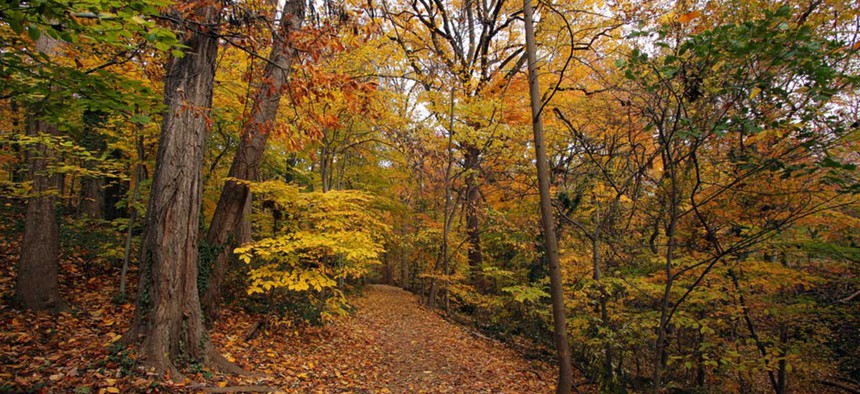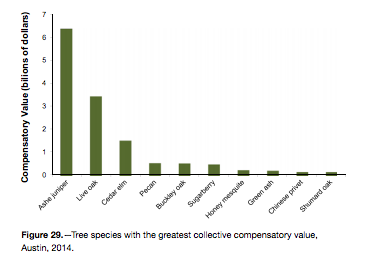
Rock Creek Park in D.C. is pictured. S.Borisov/Shutterstock.com
Meet the Forest Service Scientist Putting a Dollar Value on Urban Forests
What are trees worth to cities?
David Nowak whittles down 30 years of studying the economic value of forests to this advice: If you can only plant one tree, plant it in a city.
After all, in an era of overwhelming need for urban infrastructure improvements, trees offer cities some of the best bang for their buck. Trees remove carbon dioxide, filter air pollution, and produce oxygen. They absorb rainwater, UV radiation, and noise. They slow down traffic, improve property values, and reduce human stress and mental fatigue. And they provide shade, which means we have to use less energy to cool down.
“Trees help us avoid emissions in the first place, in addition to taking out carbon,” says Nowak, a lead researcher at the U.S. Forest Service’s Northern Research Station in Syracuse, New York. “It’s a big problem that they help us solve.”
Nowak is one of the founding developers of the Forest Service’s free software program i-Tree. Using GIS and a complex set of algorithms, it allows communities and researchers to produce detailed inventories of their urban canopies, and calculate their dollar value. A recent i-Tree analysis of Austin, Texas, led by Nowak, estimated that trees save that city nearly $19 million annually in reduced building-energy use, some $5 million in reduced carbon emissions, and account for about $16 billion as standalone physical assets. Past that, they’re worth $3 million per year in their reduction of air pollution (based on avoided respiratory health problems), and nearly $12 million per year in the amount of carbon they sequester.
Since it launched in 2006, i-Tree has grown to include all of these different ways of assessing arboreal worth. But there are still more proven benefits yet to be translated into cold, hard numbers. Right now, some of Nowak’s work is focused on calculating the dollar value of the reduced air temperatures and absorbed UV radiation that trees provide. “We have the math to show how temperature reductions are based on tree cover,” he says. But the next step, converting that into value, is really difficult. “You have to look at how how overall temperature changes, and peak temperature changes, have different impacts on human mortality,” says Nowak, “which depends on where your body is physiologically adapted from.”
If that sounds challenging, it’s a cake-walk compared to another tree-driven phenomenon Nowak is trying to quantify: Reduced stress. “Lower cortisol is given off when you see green,” he says. Using satellite imagery and i-Tree’s analytical tools, “we want to develop an index of how much green you can see from any given point in a city, how your body reacts to it, and what the economic value is,” he says. Nowak dubs this index the “green force potential,” and adds that it’s very challenging to separate out trees’ effects from other social forces that play into urban stress. “This is going to take some time,” he says. “But we think this is the next frontier of our work.”
That work matters. Tools like i-Tree and others that have followed have helped cities around the world to think more strategically about the health and sustainability of their canopies. In the U.S., Culver City, Santa Monica, Pittsburgh, San Francisco, and Tampa are all in the process of developing urban forest master plans that make use of such quantified values.

But all of that isn’t enough. Recent Forest Service research (also led by Nowak) has found that urban tree cover in the U.S. is declining at a rate of roughly four million trees per year. (That’s about 150 times the number of trees in Central Park.) Canopies are giving way to buildings and parking lots. Insects, diseases, and severe weather events are destroying their trunks and leaves—forces that climate change will compound. In many cities, tree-maintenance budgets have been stripped. Often, humans don’t easily recognize all that trees provide us.
Putting a price on urban canopies seems to be helping, though. “Money drives decisions,” Nowak says. “It’s the necessary evil of the game.”
Considering all their benefits, it seems money really does grow on trees. But given all the forces against them, trees also grow on money.






